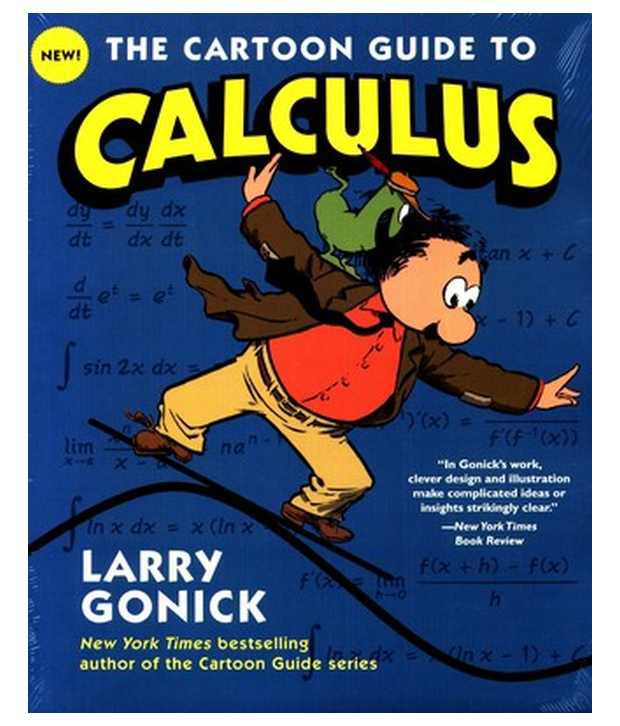
Context: Larry Gonick’s The Cartoon Guide to Calculus is a graphic novel starring Larry, himself. Larry is a self-proclaimed math geek. He has two degrees in mathematics from Harvard University. He taught Calculus at Harvard before quitting to pursue what has become his passion of making witty yet informative comics about serious subjects. Gonick has authored many books in a very similar fashion to The Cartoon Guide to Calculus. These books include The Cartoon History of the Universe, The Cartoon History of the Modern World, The Cartoon History of the United States, The Cartoon Guide to Chemistry, The Cartoon Guide to the Computer, The Cartoon Guide to the Environment, The Cartoon Guide to Physics, The Cartoon Guide to Sex, and The Cartoon Guide to Statistics, among many others. Despite the often humorous and/or informative depictions of these characters, The Cartoon Guide to Calculus doesn’t follow a well-defined plot. It generally reads more as a calculus textbook, with graphic illustrations on each page related to the material to help the reader understand content, remain engaged, and enjoy learning.
Description: In this book, Larry leads his female friend on a journey in which they explore the realm of calculus. Larry explains calculus concepts including limits, derivatives, related rates, the Mean Value Theorem, integration, and finding the area between two curves, among other topics. Along the way, Larry introduces us to other characters. At one point, we meet an interesting-looking creature who remains unnamed, but is meant to represent a function. The character inhales inputs and seemingly excretes outputs. These creatures appear throughout the book to help readers understand the content, especially when introducing the topics of differentiation and integration. The reader is also introduced to Issac Newton and Gottfried Liebniz, who are arguably the two most influential historical figures in developing modern calculus. Depictions of Newton and Liebniz in the novel typically demonstrate their ideas and contributions to calculus, but also suggest contention between the two mathematicians. All of the characters in The Cartoon Guide to Calculus serve to introduce the reader to concepts that are crucial to developing a foundational understanding of calculus.
Quotes: The Initial Conditions section of the text introduces readers to what Gonick’s style of writing will look like throughout the book. Gonick’s character says, “Open a few calculus books, and you’ll see something strange: they all look alike!! … So here and now I offer an ironclad guarantee: this calculus book will be different!!! For one thing, it doesn’t weigh very much… plus, just look at the font!” In fact, the The Cartoon Guide to Calculus is not a particularly thick book, the type is in all caps, and the font is rather cartoonish. However, what stands out about this quote is the silliness with which Gonick’s writes, and how he frequently breaks the fourth wall by addressing the reader and acknowledging his existence as a character in a book. The book goes on to describe some high level mathematics using mathematical vocabulary, but the characters in the book frequently interject to add some humor. They do this in a way that also connects with the content. For example, on page 179, Gonick is describing integration and, in particular, Riemann Sums. Gonick gives some context regarding where Riemann sums came from, explaining that 19th century mathematician Bernhard Riemann developed them and was considered so brilliant that “he won praise even from the great Gauss, who praised no one.” Gonick then depicts Bernhard Riemann considering this, asking himself, “Um… if Gauss praises no one and Gauss praises me… then… I’m no one?” Gonick’s character replies to Riemann, “Best stick to calculus, Bernie, and leave logic alone.” This humorous exchange comes after serious information about the historical origins of Riemann Sums. Yet, the exchange effectively reinforces the learning and makes it more memorable.
Why Read the Book: The Cartoon Guide to Calculus belongs to a unique genre of books that delivers textbook quality content in a humorous, engaging way. Educators today are constantly looking for new and inclusive teaching practices to reach their wide range of students. Books like Gonick’s The Cartoon Guide to Calculus are an excellent means of accomplishing this. I personally found learning much more enjoyable with this graphic novel than I’ve ever found it to be from reading through a textbook. Additionally, it provides better opportunities for students to understand the content. The illustrations from the graphic give visual means for students to understand what they are reading. Even the silly exchanges between characters can make the learning more retainable. Thus, this book has great educational value.
Argument: I would argue that The Cartoon Guide to Calculus is a very useful tool in math classroom settings. The book is filled with calculus content, but early chapters also discuss functions in depth, making the book applicable to Algebra I and Algebra II classes. I think this book also engages students a lot better than other means of delivering content, and has numerous benefits over traditional textbook readings. Since the math content is rather high-level and dense within the book, I can’t say I’d recommend The Cartoon Guide to Calculus to anybody who’s merely looking for a good graphic novel to read. However, I’d certainly recommend it to someone who wants to learn about math, because it makes the learning fun and engaging, almost to the extent that you don’t realize you’re learning.
